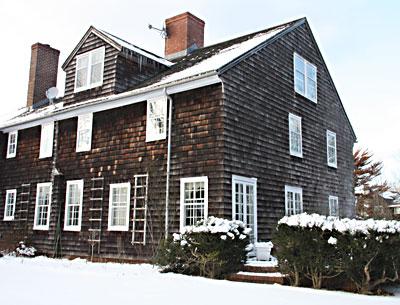A Tale of Two 18th Century Houses

The history that runs so deep on the South Fork is matched by a passion for it and, too often, by a willingness to destroy it. For notorious example, Wick’s Tavern in Bridgehampton, once catering to drinkers and gossips at the same Main Street intersection as two historic houses that made it to the 21st century, the Nathaniel Rogers House and the Bull’s Head Inn. Wick’s Tavern dated from the end of the 17th century yet was leveled in 1941 so a gas station could rise in its place. (It’s gone now, too, and won’t be missed.)
CLICK FOR MORE PHOTOS
A similar and roughly contemporaneous fate befell an East Hampton house owned by the Dominys, the family of master clock and furniture makers. Believed to have been built around 1715, it stood on North Main Street until its demise under the blades of heavy machinery in 1946. There’s nothing ugly in its stead to curse, however, only the void of a parking lot.
But Geoffrey Garrett feels its absence. For 42 years he has lived in a house not far away, on Fithian Lane, that he considers its surviving twin. His conviction on this point, born years ago when he read the book “With Hammer in Hand: The Dominy Craftsmen of East Hampton, New York” by Charles Hummel, led him to put together a meticulous 15-page report last summer comparing the two houses — from their floor plans to their identical three-batten, two-board doors, on down to their wrought-iron hinges and door handles.
He was amply aided in this by a study of the Dominy house sent to him by Mr. Hummel. The study, done by the Historic American Buildings Survey in 1940, is in the Library of Congress. But while the Dominy house is gone, Mr. Hummel, now curator emeritus of the Winterthur Museum in Delaware, was instrumental in saving manufacturing equipment and tools and making them part of the museum. The Dominy clock shop and the woodworking shop were moved to a private residence on Further Lane in East Hampton.
Mr. Garrett wanted to know what he was living in. Beyond that, his historical hackles had been up years before when village officials, in his words, “began to talk cavalierly of demolishing the Fithian house to create parking.” (That existential threat would become merely an aesthetic one, again involving a parking lot — the Citarella lot between Main Street and Fithian Lane, whose unsightliness and traffic Mr. Garrett has warded off with a substantial wooden fence of forest green.)
In his report, Mr. Garrett concludes that “the frames of the two houses, apart from size, are remarkably similar; that the interior treatments (paneling, fireplaces, etc.) are similar too . . . the coincidences are sufficiently frequent and striking to make it seem likely that the houses must have been built at approximately the same time.” Mr. Hummel put the date for the Fithian house at 1730; Robert Hefner, the village’s historic preservation consultant, at the middle of the 18th century, if not a little later.
In 1919 the former farmhouse was expanded after it was moved a short distance back from its Main Street lot, originally six acres purchased by Enoch Fithian in 1668.
To step inside the house is to be awed by wood that has stood the test of time. Of the floorboards, Jacques Peltier, who lives with Mr. Garrett, said, “They’re not only a foot and a half wide, but they’re the length of the room.”
“I believe they’re Connecticut wood,” Mr. Garrett added. One floorboard at the Dominy house was reported to be 27 inches wide.
In the library, the two men painstakingly removed eight layers of paint to reveal the original rich caramel color of the paneling. “Friends will say to us, ‘Where did you get the paneling?’ ” Mr. Peltier said.
“The extravagance in the use of wood at Fithian is remarkable,” Mr. Garrett wrote in his report. “There was (and still is) more than a quarter of a mile of 15-inch clear white pine flooring, 2 inches or so thick, at Fithian; not patchwork, but 15 foot at a shot, wall to wall. How many old-growth trees would that be?”
The horizontal feather-edge boards making up the walls of the dining room, originally the kitchen, are equally wide, at 15 inches, which is true of both houses. In one corner a fireplace — speaking of parking — could fit a small car. The same was true in the Dominy house. A beehive oven sits elevated at its rear.
“Both houses rest on tree trunks, flattened on top to receive the floorboards,” Mr. Garrett wrote. In the basement of the Fithian house, there are supporting beams of logs with the bark still on them and ax-hewn joists. A couple of years ago Mr. Garrett cut a slice from a joist and sent it to the Oxford Dendrochronology Laboratory in England for scientific dating, but the results were inconclusive.
Mr. Garrett was a research scientist in his own right, which helps explain the detailed analysis, illustrative figures carefully numbered, and appendix in his Fithian house report. He worked at Bell Labs in New Jersey, specializing in lasers.
He bought the Fithian house in 1970 from Virginia Gurnee, whose companion, Helen Jacobs, had been a tennis champion at Wimbledon. Among the friends they entertained was the actress Bette Davis, who was convinced there was a pirate’s treasure to be found in the house.
Mr. Garrett did come across an old whiskey bottle and a sextant once, but the real treasure is in all that wood — and all that East Hampton history.
